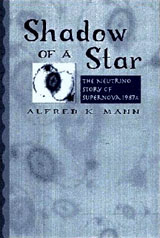
The secrets of the universe made boring
|
This review first appeared in the August 1-2, 1998 issue of the American Reporter.
Alfred K. Mann could write about sex and put you to sleep.
His book about the discovery of neutrinos from a distant supernova in 1987 could have been – should have been – one of the best science books of 1997.
Instead, "Shadow of a Star" is boring reading – not drudgery to get through, perhaps, but not so far removed, either.
It's not that the story lacks drama or intrigue. Mann was on a team of American and Japanese physicists and astronomers who devised a new instrument – a huge underwater tank of water with radiation collectors – to detect neutrinos from our own sun. (Neutrinos are a type of elementary particle with little or no mass that interact only very weakly with other matter – protons, neutrons, electrons.)
Yet when the new neutrino telescope was activated, it wasn't neutrinos from the sun it found (at least not at first) but a burst from a just-discovered supernova in a nearby galaxy. (A supernova occurs when a giant star – thousands to millions of times more massive than our sun – runs out of nuclear fuel and explodes, becoming momentarily brighter than an entire galaxy. Supernova are vitally important to life, because it is in supernova that all elements heavier than iron are formed.)
So the story itself is fascinating. And Mann certainly knows the material inside and out. He's been at the forefront of the physical sciences since a stint on the Manhattan Project that developed atomic weapons for the Allies during World War II.
But as with many scientists, Mann feels the need to explain everything as if talking to a child, and in so doing he dulls the reader's curiosity and interest. Mann overexplains every facet of the experiment and devotes far too much of the book going over basic principles of physics that, quite frankly, anyone interested in this book will have already picked up elsewhere. Mann also has an annoying habit of using the last paragraph or two of each chapter summarizing what we just read and telling us what the next chapter will be about.
Too, Mann's anthropomorphism of the cosmos is a bit much, especially coming from an esteemed physicist. For instance, in Chapter One, he writes of the supernova: "It is an event with far more violence than humans can produce, but unlike much of our violence, it is not mindless."
Really? So just what is Mann proposing – creationism? Or perhaps sentience among the stars?
And toward the end of the book, in explaining how neutrinos are expelled from a collapsing supernova about to become a neutron star, Mann chooses to portray the event as a choice the star makes – that only be expelling neutrinos and antineutrinos in equal parts can the star become a neutron star.
Sigh.
The book is still worth a read because of Mann's intimate knowledge of the project and the importance of the discovery in terms of what it tells us about the workings of our universe. But quite frankly, Mann makes his little pocket-sized hardcover read like a more massive tome.
Which should remind us yet again how precious are our top-notch popular science writers such as Timothy Ferries, Paul Davies or, dare I say it, the late Carl Sagan. For all their over-simplification, they preserve a passion and immediacy that keeps alive the public's interest in pure science.
